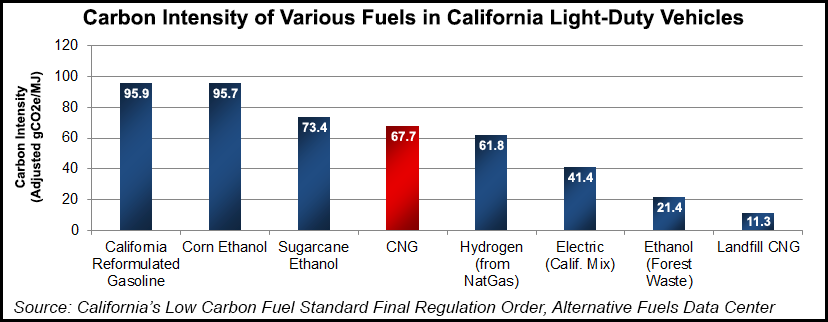Infrastructure | NGI All News Access
California Outlines Stepped-Up Alternative Transportation Fuels Push
In approving the latest update in the state’s integrated energy policy report (IEPR), the California Energy Commission has called for pushing the pedal to the metal on transforming the state transportation system to zero- and near-zero-emission technologies.

Natural gas and biofuels, including renewable natural gas (RNG), received a lot attention in the IEPR through the CEC’s ongoing research grants. “Biofuels will also play a critical role in reducing carbon emissions from the transportation sector,” the latest IEPR document said.
Under the CEC’s Alternative and Renewable Fuel and Vehicle Technology Program (ARFVTP), 60 natural gas vehicle (NGV) fueling stations have been funded, increasing the state’s overall stations 14% to 443 stations. Similarly, CEC grants have helped support the purchase of 2,725 NGV trucks, boosting the state’s natural gas truck census 19% to nearly 14,000.
At the end of last year, the CEC research and development grant programs had committed $532 million to more than 460 projects. “Funding this large portfolio of projects was the result of the CEC issuing nearly two-dozen solicitations and reviewing more than 600 technical proposals from entities seeking funding,” the CEC report said.
Initiatives include the development and commercialization of heavy-duty NGV engines and converting waste streams to RNG.
Last Wednesday, the CEC approved $3 million in funding to the City of Napa, CA, for a program to modify its materials diversion facility so it can convert 25,000 tons of organic waste annually into 328,000 diesel-gallons-equivalent of RNG and to install a RNG fueling station.
And among $900,000 of new grants to natural gas projects, the CEC authorized two grants totaling $295,000 to San Diego-based Quantitative BioSciences Inc. ($150,000) to demonstrate a process for cleaning biogas from wastewater to make it useable as compressed natural gas (CNG) for NGVs, and to San Francisco-based Otherlab ($145,000) to determine the feasibility of using spiral tubes made of braided fiber composite to create a low-profile CNG tank.
Separately, the nation’s alternative fuel and vehicle trade associations, including NGVAmerica, sent a letter on Thursday to the Senate and House Energy/Water Appropriations Subcommittee to support continued funding for the U.S. Department of Energy’s (DOE) Clean Cities Program, which has spawned nearly 100 local coalitions, representing 14,000 stakeholders in the alternative transportation sector. The groups are seeking Congress’ allocation of $50 million in funding, including $25 million in competitive grants.
The latest Clean Cities 2015 Buyers Guide was released in February and is available online. It is geared to drivers who want information on their alternative vehicle options. DOE said there are now more than 20 million light-duty alternative fuel vehicles on U.S. roadways.
In Texas, the firm CNG 4 America said it signed an agreement with 7 Star Travel to build a CNG fueling station at 7 Star’s travel center in Sulphur Springs, TX. It will provide fast-fill CNG fueling to heavy-duty trucks, along with medium- and light-duty NGVs, offering four fueling lanes and two CNG fast-fill dispensers.
“This is just the beginning of signing multiple station agreements in North Texas,” CNG 4 America’s Tim Williams told Fleets & Fuels newsletter.
In Pennsylvania, beverage distributor LT Verrastro said it has committed its fleet to CNG, installing a CNG fueling facility in Old Forge, PA, to support 10 Peterbilt 337 trucks and 25 Nissan NV 1500 natural gas vans. The vans are bi-fuel vehicles and the trucks are dedicated NGVs.
© 2024 Natural Gas Intelligence. All rights reserved.
ISSN © 1532-1231 | ISSN © 2577-9877 |
